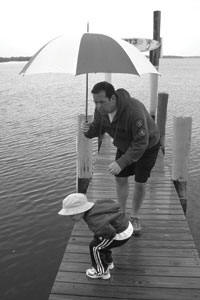|
 The
subjects for black-and-white photography might seem limited.
For example, traditional subjects include landscapes,
portraits, still lifes, and everyday scenes. The
subjects for black-and-white photography might seem limited.
For example, traditional subjects include landscapes,
portraits, still lifes, and everyday scenes.
A
portrait, just to consider one of these, can be formal,
candid, environmental, representative, and more. This does
not even consider the different people to be photographed,
lighting conditions, season, background, or the many
elements that affect the final photograph.
Beginning photographers are the most pliable when it comes
to outside influences. They are typically still searching
for a style, honing their skills, and unsure of their
abilities. For these reasons and others, many photographers
have a difficult time choosing appropriate subjects for
their photography.
Especially for beginning photographers, choosing subjects is usually
the best place to start. I often have students complain
there are no subjects. “There’s nothing interesting to
photograph,” is a common refrain. I advise them to take
pictures of things they like, whether those things seem
interesting or not. I’ve found that when we’re photographing
subjects in which we’re interested, we are more likely to
look for a good image.
 Beginners often photograph their subjects literally. There’s
nothing wrong with that. Many times, though, an ordinary
subject can be made extraordinary. That is rarely due to the
subject and almost always a reflection of the photographer. Beginners often photograph their subjects literally. There’s
nothing wrong with that. Many times, though, an ordinary
subject can be made extraordinary. That is rarely due to the
subject and almost always a reflection of the photographer.
Most
viewers like dynamic photographs. To make a dynamic
photograph, you must see the shapes, lines, and tones that
make up a black-and-white photograph. In a sense, the
photographer must learn to break down the subject into its
basic compositional elements, and then build an image from
them.
By
beginning to look at your compositions as visual elements,
rather than merely literal subjects, you will go a long way
towards taking photographs of which to be proud. Remember:
Photographic images are made of tone, shapes, and lines.
Their relationships will make it easier for you to find a
good composition – no matter what the subject. And you’ll
learn even old subjects can be shot anew!
Part two of a
two-part series, provided by Bernhard J. Suess
for the New York Institute of Photography (www.nyip.com).
|